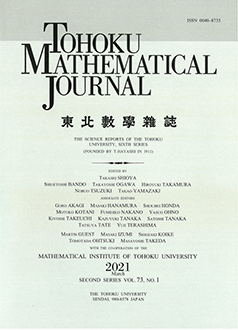For any prime number $p$, we study local triviality of the ideal class group of the ${\boldsymbol Z}_p$-extension over the rational field. We improve a known general result in such study by modifying the proof of the result, and pursue known effective arguments on the above triviality with the help of a computer. Some explicit consequences of our investigations are then provided in the case $p\leq7$.
References
T. Fukuda and K. Komatsu, Weber's class number problem in the cyclotomic $\boldsymbol Z_2$-extension of $\boldsymbol Q$, Experiment. Math. 18 (2009), 213--222. MR2549691 05644742 euclid.em/1259158432
T. Fukuda and K. Komatsu, Weber's class number problem in the cyclotomic $\boldsymbol Z_2$-extension of $\boldsymbol Q$, Experiment. Math. 18 (2009), 213--222. MR2549691 05644742 euclid.em/1259158432
K. Horie, Ideal class groups of Iwasawa-theoretical abelian extensions over the rational field, J. London Math. Soc. (2) 66 (2002), 257--275. MR1920401 1011.11072 10.1112/S0024610702003502K. Horie, Ideal class groups of Iwasawa-theoretical abelian extensions over the rational field, J. London Math. Soc. (2) 66 (2002), 257--275. MR1920401 1011.11072 10.1112/S0024610702003502
K. Horie, Primary components of the ideal class group of the $\boldsymbol Z_p$-extension over $\boldsymbol Q$ for typical inert primes, Proc. Japan Acad. Ser. A Math. Sci. 81 (2005), 40--43. MR2128929 10.3792/pjaa.81.40 euclid.pja/1116442034
K. Horie, Primary components of the ideal class group of the $\boldsymbol Z_p$-extension over $\boldsymbol Q$ for typical inert primes, Proc. Japan Acad. Ser. A Math. Sci. 81 (2005), 40--43. MR2128929 10.3792/pjaa.81.40 euclid.pja/1116442034
K. Horie, The ideal class group of the basic $\boldsymbol Z_p$-extension over an imaginary quadratic field, Tohoku Math. J. (2) 57 (2005), 375--394. MR2154097 10.2748/tmj/1128703003 euclid.tmj/1128703003
K. Horie, The ideal class group of the basic $\boldsymbol Z_p$-extension over an imaginary quadratic field, Tohoku Math. J. (2) 57 (2005), 375--394. MR2154097 10.2748/tmj/1128703003 euclid.tmj/1128703003
K. Horie, Certain primary components of the ideal class group of the $\boldsymbol Z_p$-extension over the rationals, Tohoku Math. J. (2) 59 (2007), 259--291. MR2347423 10.2748/tmj/1182180736 euclid.tmj/1182180736
K. Horie, Certain primary components of the ideal class group of the $\boldsymbol Z_p$-extension over the rationals, Tohoku Math. J. (2) 59 (2007), 259--291. MR2347423 10.2748/tmj/1182180736 euclid.tmj/1182180736
K. Horie, Primary components of the ideal class group of an Iwasawa-theoretical abelian number field, J. Math. Soc. Japan 59 (2007), 811--824. MR2344829 1128.11052 10.2969/jmsj/05930811 euclid.jmsj/1191591859
K. Horie, Primary components of the ideal class group of an Iwasawa-theoretical abelian number field, J. Math. Soc. Japan 59 (2007), 811--824. MR2344829 1128.11052 10.2969/jmsj/05930811 euclid.jmsj/1191591859
K. Horie and M. Horie, The narrow class groups of some $\boldsymbol Z_p$-extensions over the rationals, Acta Arith. 135 (2008), 159--180. MR2453530 1158.11046 10.4064/aa135-2-5 K. Horie and M. Horie, The narrow class groups of some $\boldsymbol Z_p$-extensions over the rationals, Acta Arith. 135 (2008), 159--180. MR2453530 1158.11046 10.4064/aa135-2-5





